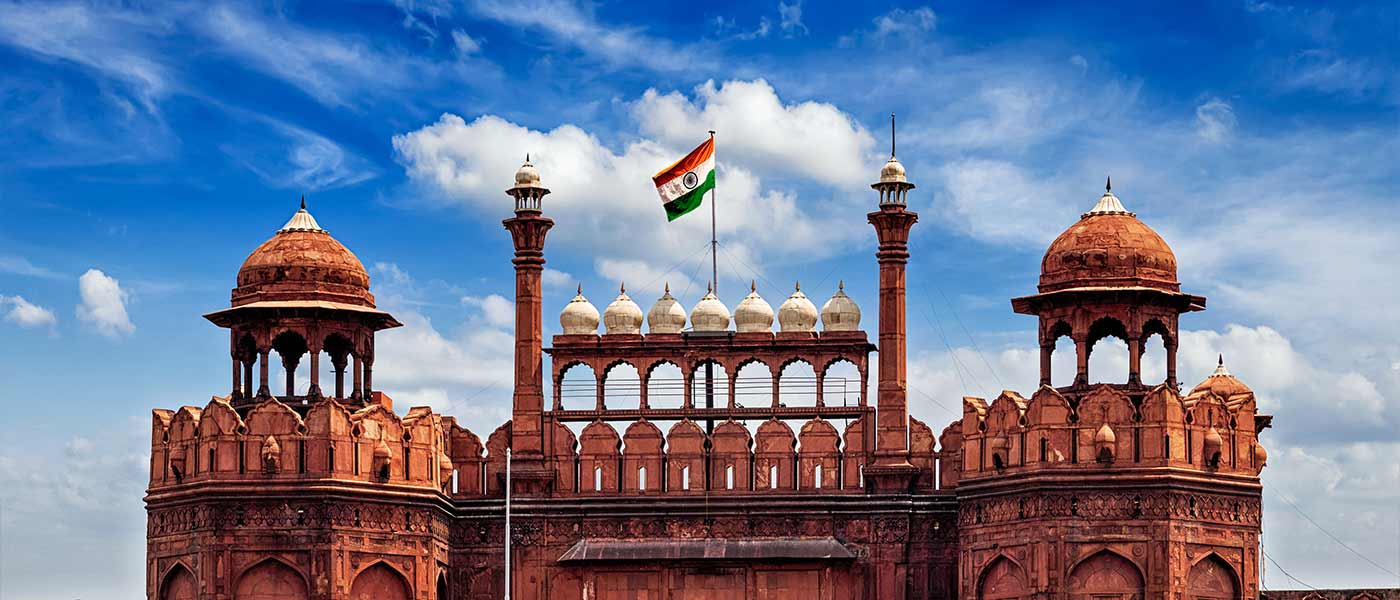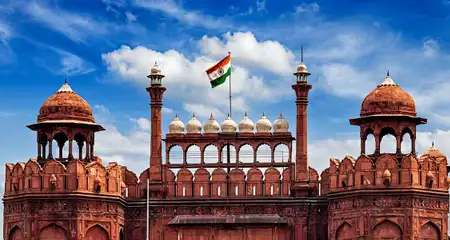The Red Fort in Delhi is an evergreen attraction that has stood the test of time and fascinates travelers all year along. This historic fort, also known as Lal Qila, with over 370 years of history will remind you of the grandeur of the Mughal Empire. And that makes it a prime attraction to add to your itinerary as you plan a trip and book your hotels in Delhi.
Want to know more about this top heritage monument in Delhi? Here is everything you should know, such as the history, timings, entry fee, and other details about the Red Fort in Delhi.
Red Fort Information:
| Location | Old Delhi |
| Timings | 9:30 am to 4:30 pm; closed on Mondays |
| Entry Fee | ₹ 35 for Indians; ₹ 500 for foreigners |
| Nearest Metro Station | Lal Qila |
| Video Camera | ₹ 25 |
| Also Known as | Lal Qila |
| Commissioned by | Shah Jahan |
| Year of Establishment | 1639 to 1648 |
| Architect | Ustad Ahmad Lahori |
| Architectural Style | Mix of Islamic, Hindi, Timurid, and Persian styles |
| Status | UNESCO World Heritage Site |
| Area | 255 acres |
| Length of Enclosing Walls | 2.5 km |
| Materials Used | Red sandstone |
Red Fort: History
The Red Fort was built by none other than the Mughal Emperor Shah Jahan to serve as the palace fort for his capital Shahjahanabad. He commissioned the construction of the fort by the River Yamuna when he decided to shift his capital to Delhi from Agra. The construction, which started in 1638, took over 8 years to complete. The structure was originally named Qila-i-Mubarak, which means ‘the Blessed Fort’. During its history of over three centuries, the fort saw many occupants, including Aurangzeb, Jahandar Shah, Muhammad Shah, and Bahadur Shah II, among others.
The Red Fort underwent massive destruction in 1739 when the Persian ruler Nadir Shan invaded the city and plundered the fort of many valuable artifacts, including the Peacock Throne. Later, during the 1857 Revolt against the British, the marble structures of the fort were also destroyed.
Red Fort Architecture
The fort, which is spread over 255 acres, features a mix of architectural styles such as Islamic, Hindi, Timurid, and Persian. Its massive, 2.5-km-long enclosing walls are made of red sandstone and that’s where the monument got its name from. A few parts of the fort are also made of red stone while the remaining structure is built using marble. The structure, which is in the shape of an irregular octagon, incorporates elements of garden design and also features turrets, bastions, pavilions, two gates, and several other sections.
Red Fort: Today
Today, the Red Fort is one of the top tourist places in Delhi. Every year, the Prime Minister of the country hoists the national flag on Independence Day at this historical monument. The PM also delivers a speech from its ramparts. In 2007, this iconic edifice was included in the list of UNESCO World Heritage Sites in Delhi for its architectural splendor and historical significance. The property is now under the control of the Archeological Survey of India.
Things to See in the Red Fort Complex
The Red Fort is located next to the historical Salimgarh Fort. These two forts together form the Red Fort Complex with several attractions within it, including:
- Lahori Gate, the main entrance to the fort
- Delhi Gate, the public entrance at the southern end
- Chatta Chowk, a long passageway with a bazaar
- Mumtaz Mahal, a palace that houses Red Fort Archaeological Museum
- Rang Mahal, a palace where the emperor’s wives and mistresses were housed
- Khas Mahal, the apartment of the emperor
- Diwan-i-Aam, the public audience hall
- Diwan-i-Khas, the private audience hall
- Hira Mahal, a marble pavilion built by Bahadur Shah II
- Princes’ quarters, imperial quarter’s used by members of the royal Mughal family
- Tea House, one of the Prince’s quarters which is currently a working restaurant
- Naubat Khana, the drum house which now houses the Indian War Memorial Museum
- Nahr-i-Bihisht, a canal that runs through the pavilions
- Hammam, the imperial baths
- Baoli, a uniquely designed step-well
- Moti Masjid, which was the private mosque of Aurangzeb
- Hayat Baksh Bagh, a garden within the fort
Red Fort Light and Sound Show
A key attraction at the fort is the light and sound show held in the evenings. Touted as one of the best light and sound shows in India, the Red Fort light and sound show takes you through the history of the monument in an interesting and visually appealing manner. The show ends with a short speech by Jawaharlal Nehru. You can book the show online or buy tickets from the booths at the fort.
- Duration: 60 minutes
- Timings*:
Hindi – 7:30 pm to 8.30 pm
English – 9.00 pm to 10.00 pm
* Timings might vary slightly based on the season. - Tickets:
Weekdays – ₹ 60 for adults; ₹ 20 for kids
Weekends and Public Holidays – ₹ 80 for adults; ₹ 30 for kids
Lesser Known Facts about the Red Fort
- The fort was designed in red and white because those were the favorite colors of Shah Jahan.
- In 2018, the Archeological Survey of India took initiatives to illuminate the fort for night viewing. Read our news report on the illumination of Delhi monuments for more details.
- The fort is featured on the back of the new 500 rupees currency.
- In 2019, the PM of India inaugurated five more museums in Red Fort – the Subhash Chandra Bose Museum, the Museum of 1857, Yaad-e-Jallian, Drishyakala, and Azaadi Ke Deewane.
Attractions Near Red Fort
- Shri Digamber Jain Lal Mandir (300 m)
- Gauri Shankar Mandir (300 m)
- Gurdwara Sis Ganj Sahib (750 m)
- Jama Masjid (900 m)
- Chandni Chowk Market (1.5 km)
- Raj Ghat (2 km)
- Khari Baoli Spice Market (3 km)
- Fatehpuri Masjid (3 km)
- Stephen’s Church (3 km)
- India Gate (7 km)
- Humayun’s Tomb (9 km)
Now that you know everything about the Red Fort in Delhi, are you all set to explore this heritage monument like a pro? Go ahead and listen to history speaking through every inch of the fort, and soak in its architectural grandeur.




























